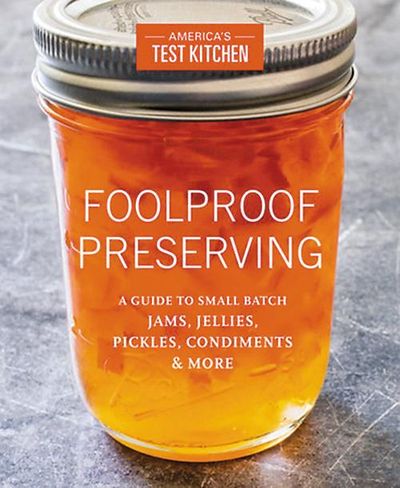Cookbook review: ‘Foolproof Preserving’ shows science behind boiling water canning

Quick look: Just ahead of summer’s bounty, this new cookbook demystifies the process of preserving foods through boiling water canning.
What’s inside: It’s easy to understand why home preserving makes many people anxious. “When canning, specifics really matter; otherwise, you may end up with jam that never sets, pickles that aren’t crisp, lids that don’t seal – or worse,” the editors at America’s Test Kitchen write in the introduction to this book, published Tuesday.
The well-organized guide from one of America’s most trusted culinary brands breaks down the science and offers a comprehensive guide to boiling water canning. Its 100 recipes include classics and step-by-step instructions, which is helpful for beginners. But the 310-page, softcover book also features fancy flavor combinations and more advanced recipes to appeal to and keep canning interesting for home preservers of all levels.
Terms are described in the introduction, with photos showing each type of preserve – from chutney and conserve to relish and vinegar pickles. A troubleshooting section offers solutions for common canning mistakes, and there’s even a page that describes putting together an eight-piece canning kit.
Recipes focus on small batches and are divided by preserve type: sweet jams and jellies, savory jams and chutneys, pickles, tomatoes year-round, fruit in syrup, and condiments and fruit butters. Look for classics such as giardiniera, sauerkraut, kimchee, fruit cocktail, Dijon mustard, preserved Meyer lemons, applesauce, apple butter, and strawberry, blueberry, raspberry and peach jams. Look, also, for modernized, elevated and maybe more interesting recipes such as pickled curried cauliflower, blood orange marmalade, mulled cider jelly, red pepper jelly, simple hot sauce and strawberry-basil, blueberry-earl grey, peach-bourbon, fig-pomegranate, caramelized onion, fig-balsamic and bacon jams.
All recipes include at least one inspiring, vibrant and light-filled image. Most include several.
All come with America’s Test Kitchen’s signature “Why This Recipe Works” explanation. Many also include tips for doubling the recipe as well as list suggested uses, such as filling thumbprint cookies, glazing pork chops, spreading on bagels and sandwiches, pairing with brie or goat cheeses, or stirring into yogurt.
What’s not: This book doesn’t cover pressure canning. So if you want to can soups, stocks, meats, seafoods or unpickled vegetables, you’ll need a different manual.
On the Web: foolproofpreserving.com.
Blueberry-Earl Grey Jam
From “Foolproof Preserving” by America’s Test Kitchen
1 1/2 cups sugar
1 tablespoon Sure-Jell for Less or No Sugar Needed Recipes (Do not substitute)
15 ounces (3 cups) blueberries
5 earl grey tea bags, strings and tags removed (America’s Test Kitchen recommends Twinings Earl Grey Tea)
1 tablespoon bottled lemon juice (Do not substitute)
1/2 teaspoon grated lemon zest
Combine ¼ cup sugar and Sure-Jell in bowl. Bring blueberries, tea bags, lemon juice and lemon zest to a simmer in large saucepan over medium-high heat. Reduce heat to medium-low and simmer, stirring occasionally, until blueberries have softened and released their juice, about 5 minutes.
Bring mixture to boil over high heat. Whisk in Sure-Jell mixture and bring to boil. Whisk in remaining 1 ¼ cups sugar and bring to vigorous boil. Once boiling, cook for 1 minute, whisking constantly. Remove pot from heat. Discard tea bags, gently brushing off excess jam, and skim any foam from surface of jam using spoon.
Meanwhile, place two 1-cup jars in bowl and place under hot running water until heated through, 1 to 2 minutes, shake dry.
Using funnel and ladle, portion hot jam into hot jars. Let cool to room temperature, cover, refrigerate until jam is set, 12 to 24 hours. (Jam can be refrigerated for up to 2 months.)
Note: This recipe is meant for short-term storage only, but it can be processed for long-term safe-keeping – following instructions in the book.
Yield: 2 (1-cup) jars